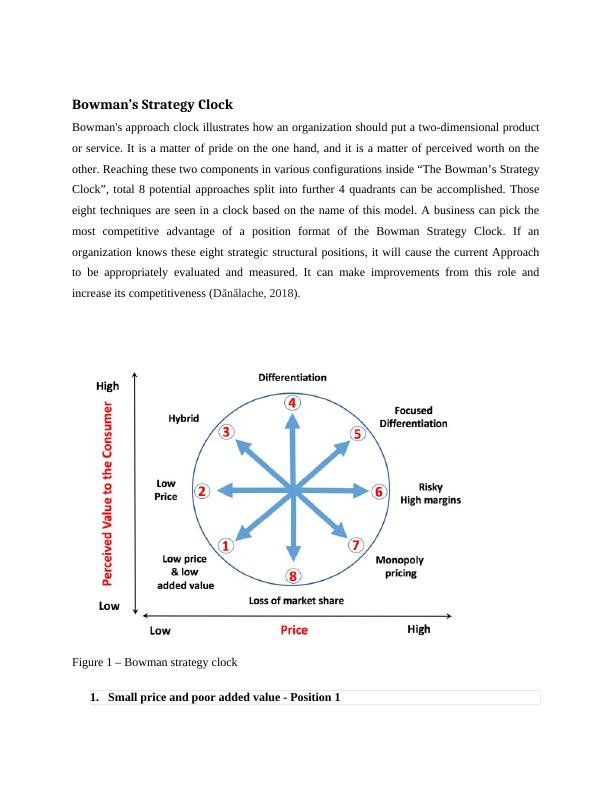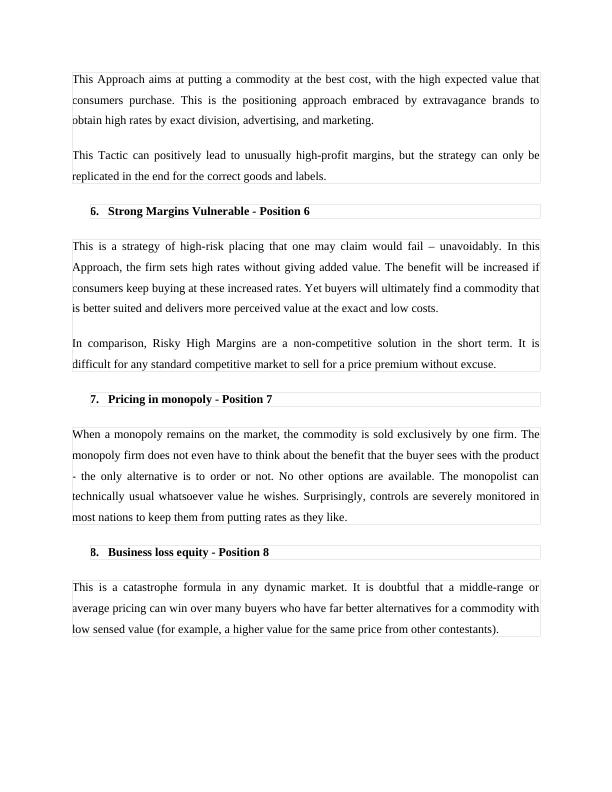(Doc) Bowman’s Strategy Clock
Added on 2021-09-27
8 Pages2515 Words250 Views
Bowman’s Strategy Clock
Bowman's approach clock illustrates how an organization should put a two-dimensional product
or service. It is a matter of pride on the one hand, and it is a matter of perceived worth on the
other. Reaching these two components in various configurations inside “The Bowman’s Strategy
Clock”, total 8 potential approaches split into further 4 quadrants can be accomplished. Those
eight techniques are seen in a clock based on the name of this model. A business can pick the
most competitive advantage of a position format of the Bowman Strategy Clock. If an
organization knows these eight strategic structural positions, it will cause the current Approach
to be appropriately evaluated and measured. It can make improvements from this role and
increase its competitiveness (Dănălache, 2018).
Figure 1 – Bowman strategy clock
1. Small price and poor added value - Position 1
Bowman's approach clock illustrates how an organization should put a two-dimensional product
or service. It is a matter of pride on the one hand, and it is a matter of perceived worth on the
other. Reaching these two components in various configurations inside “The Bowman’s Strategy
Clock”, total 8 potential approaches split into further 4 quadrants can be accomplished. Those
eight techniques are seen in a clock based on the name of this model. A business can pick the
most competitive advantage of a position format of the Bowman Strategy Clock. If an
organization knows these eight strategic structural positions, it will cause the current Approach
to be appropriately evaluated and measured. It can make improvements from this role and
increase its competitiveness (Dănălache, 2018).
Figure 1 – Bowman strategy clock
1. Small price and poor added value - Position 1

This does not work for an organization. The product is not distinctive and the customer earns
very little advantage despite a low price.
This is a negotiation-based strategy. You are 'cheap as chips' and hope nobody can dismiss you
the only way to be successful.
2. Low cost - Position 2
Companies who put themselves here look similar to the low-cost business leaders.
To thrive, this is also related to economies of scale. A cost-cutting approach is required. Each
commodity has poor revenue margins, but significant making levels will also yield higher total
profits.
Rivalry between low-cost firms is typically severe – often involving price wars (Haselwanter et
al., 2016).
3. Hybrid - Position three
As the name suggests, a hybrid position entails a particular aspect of low-price and a specific
distinction of goods. Its mission is to reassure customers that a reasonable values as well as
suitable product distinction combine positive benefit.
This could be a powerful technique for placement, specifically if the benefit is consistently
offered.
4. Distinguishing - Position 4
The objective of a differentiation method is to have the most apparent value provided to
customers. Marketing and product consistency plays an integral part in this Approach.
The best place to attain comparatively reasonable prices and add value that a differentiation
approach needs might be a high-quality commodity with solid market recognition and loyalty.
5. Differentiation based - Position 5
very little advantage despite a low price.
This is a negotiation-based strategy. You are 'cheap as chips' and hope nobody can dismiss you
the only way to be successful.
2. Low cost - Position 2
Companies who put themselves here look similar to the low-cost business leaders.
To thrive, this is also related to economies of scale. A cost-cutting approach is required. Each
commodity has poor revenue margins, but significant making levels will also yield higher total
profits.
Rivalry between low-cost firms is typically severe – often involving price wars (Haselwanter et
al., 2016).
3. Hybrid - Position three
As the name suggests, a hybrid position entails a particular aspect of low-price and a specific
distinction of goods. Its mission is to reassure customers that a reasonable values as well as
suitable product distinction combine positive benefit.
This could be a powerful technique for placement, specifically if the benefit is consistently
offered.
4. Distinguishing - Position 4
The objective of a differentiation method is to have the most apparent value provided to
customers. Marketing and product consistency plays an integral part in this Approach.
The best place to attain comparatively reasonable prices and add value that a differentiation
approach needs might be a high-quality commodity with solid market recognition and loyalty.
5. Differentiation based - Position 5

This Approach aims at putting a commodity at the best cost, with the high expected value that
consumers purchase. This is the positioning approach embraced by extravagance brands to
obtain high rates by exact division, advertising, and marketing.
This Tactic can positively lead to unusually high-profit margins, but the strategy can only be
replicated in the end for the correct goods and labels.
6. Strong Margins Vulnerable - Position 6
This is a strategy of high-risk placing that one may claim would fail – unavoidably. In this
Approach, the firm sets high rates without giving added value. The benefit will be increased if
consumers keep buying at these increased rates. Yet buyers will ultimately find a commodity that
is better suited and delivers more perceived value at the exact and low costs.
In comparison, Risky High Margins are a non-competitive solution in the short term. It is
difficult for any standard competitive market to sell for a price premium without excuse.
7. Pricing in monopoly - Position 7
When a monopoly remains on the market, the commodity is sold exclusively by one firm. The
monopoly firm does not even have to think about the benefit that the buyer sees with the product
- the only alternative is to order or not. No other options are available. The monopolist can
technically usual whatsoever value he wishes. Surprisingly, controls are severely monitored in
most nations to keep them from putting rates as they like.
8. Business loss equity - Position 8
This is a catastrophe formula in any dynamic market. It is doubtful that a middle-range or
average pricing can win over many buyers who have far better alternatives for a commodity with
low sensed value (for example, a higher value for the same price from other contestants).
consumers purchase. This is the positioning approach embraced by extravagance brands to
obtain high rates by exact division, advertising, and marketing.
This Tactic can positively lead to unusually high-profit margins, but the strategy can only be
replicated in the end for the correct goods and labels.
6. Strong Margins Vulnerable - Position 6
This is a strategy of high-risk placing that one may claim would fail – unavoidably. In this
Approach, the firm sets high rates without giving added value. The benefit will be increased if
consumers keep buying at these increased rates. Yet buyers will ultimately find a commodity that
is better suited and delivers more perceived value at the exact and low costs.
In comparison, Risky High Margins are a non-competitive solution in the short term. It is
difficult for any standard competitive market to sell for a price premium without excuse.
7. Pricing in monopoly - Position 7
When a monopoly remains on the market, the commodity is sold exclusively by one firm. The
monopoly firm does not even have to think about the benefit that the buyer sees with the product
- the only alternative is to order or not. No other options are available. The monopolist can
technically usual whatsoever value he wishes. Surprisingly, controls are severely monitored in
most nations to keep them from putting rates as they like.
8. Business loss equity - Position 8
This is a catastrophe formula in any dynamic market. It is doubtful that a middle-range or
average pricing can win over many buyers who have far better alternatives for a commodity with
low sensed value (for example, a higher value for the same price from other contestants).

End of preview
Want to access all the pages? Upload your documents or become a member.
Related Documents
Bowman Strategy Clock for Small and Medium Enterprises in Spainlg...
|6
|816
|109
Strategic Management Assignment Samplelg...
|6
|806
|77
Bowman's Strategic Clock: Essaylg...
|7
|1570
|657
Bowman's Strategic Clock Tool and Amazon Case Studylg...
|18
|4102
|1616
Business Strategy Plan of Volkswagen Assignmentlg...
|20
|5188
|542
Strategic Marketing Management: Doclg...
|10
|2410
|89
